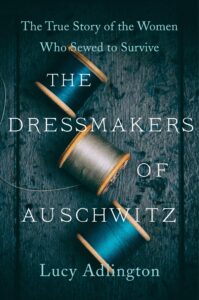By Lucy Adlington
 High ranking Nazi wives wore dazzling couturier dresses made by prisoners at Auschwitz working in an exclusive dressmaking studio.
High ranking Nazi wives wore dazzling couturier dresses made by prisoners at Auschwitz working in an exclusive dressmaking studio.
THE DRESSMAKERS OF AUSCHWITZ (2021) tells the stories of 25 women who worked in the Upper Tailoring Studio established at Auschwitz by Hedwig Höss, wife of commandant Rudolf Höss.
Hedwig became the envy of SS wives after wearing clothes made by her prisoner/servant Marta Fuchs. Elite Nazi women such as Magda Goebbels, wife of Propaganda Minister Joseph Goebbels; Emmy Goering, wife of Reichsmarschall Hermann Goering; and Eva Braun, Hitler’s mistress, loved couture clothing.
Mrs. Goebbels and Mrs. Goering were likely customers of the Upper Tailoring Studio. The order book was lost when the Nazis destroyed records as they prepared to flee from the advancing Soviet Army in 1945. Little information about the studio exists. Author Lucy Adlington discovered it as she researched archives from the 1930s and ’40s for a book.
Between the two world wars, about 80 percent of German department and chain stores were owned by Jews. Almost half the wholesale textile firms were owned by Jews.
“Berlin was an acclaimed centre of women’s read-to-wear apparel thanks to the energies and intelligence of Jewish entrepreneurs, over a century of development,” Adlington writes.
But as the Nazis forced Jews out of the fashion and textile industries beginning in 1933, they were replaced with non-Jews lacking experience and talent.
After Kristallnacht, Magda Goebbels lamented the closure of a Jewish salon: “What a nuisance that Kohnen is closing . . . we all know that when the Jews go, so will the elegance from Berlin.”
Despite their anti-semitism, Nazis wives had no difficulty wearing clothes designed by Jews in concentration camps or luxury goods stolen the suitcases abandoned when their owners were sent to the gas chambers.
Adlington follows the stories of the dressmakers from before the war, through their years in Auschwitz and beyond. Most of her book, though, outlines the history of the textile and fashion industries in Germany and the impact of Nazi antisemitism on them.
Marta, a talented pattern-cutter, had run her own successful salon in Bratislava until deported to Auschwitz in 1942. She helped the camp’s resistance organization, passed information learned through the work at the studio and planned an escape for herself.
One of her seamstresses had worked for Chanel in Paris. Another learned tailoring at her father’s side. Still others were professional designers and seamstresses.
For the studio’s dressmakers, it was a way to avoid the gas chambers. They had better accommodations, access to showers and better food than the typical Auschwitz inmate. The Nazis showed off the dressmakers’ quarters when the International Red Cross visited, hiding the actual living conditions of most of the death camp’s prisoners.
The studio was disbanded on Jan. 17, 1945. Höss was reassigned to Ravensbrück and the Russians were advancing.
This book is difficult to read at times. There are anecdotes of heart-breaking poignancy here. In one, Katka Berchovic, working in one of the massive warehouses processing the belongings of gassed Jews, finds her own coat and that of her sister Bracha in the mounds of clothing and abandoned valuables.
She knows at once her parents are dead. Preparing for deportation to Lublin in June 1942, they most likely packed their daughters’ coats planning to return them when they were reunited. Instead they were murdered, probably in Majdanek, and their belongings shipped to Auschwitz for sorting.
Another book offering a view of life in Auschwitz is Jonathan Dunsky’s THE AUSCHWITZ DETECTIVE.
The Author: Lucy J. Adlington
Lucy Adlington is an author, presenter and clothes historian. She writes history-inspired fiction and books on social history.
She’s a keen collector of vintage and antique costume.
Her novels include SUMMERLAND; THE RED RIBBON; THE DIARY OF PELLY-D; CHERRY HEAVEN; THE GLITTERING EYE; BURNING MOUNTAIN; and NIGHT WITCHES.
Her nonfiction works include STITCHES IN TIME, GREAT WAR FASHION, FASHION; WOMEN IN WORLD WAR ONE; OPENING THE WARDROBE; and WOMEN’S LIVES AND CLOTHES IN WW2.
She lives on a working farm in northern England.
#lucyadlington #thedressmakersofauschwitz #jeannettehartman


